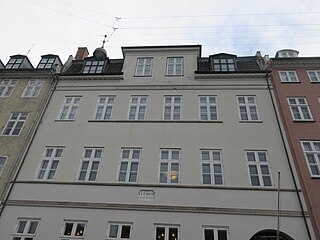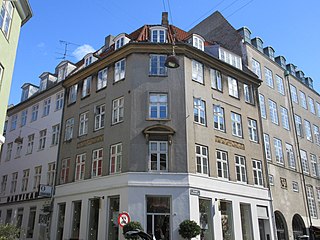
The Verrayon House is a Rococo, bourgeoisie townhouse located at Lille Strandstræde 6 in central Copenhagen, Denmark. It was listed by the Danish Heritage Agency in the Danish national registry of protected buildings in 1943.

Nyhavn 13 is a historic townhouse overlooking the Nyhavn Canal in central Copenhagen, Denmark. With roots dating back to the late 17th century, it owes its current appearance to a heightening of the building with two floors in 1842. Notable former residents include the businessman Abraham Marcus Hirschsprung and the painter and educator Wilhelm Kyhn. The building was listed in the Danish registry of protected buildings and places in 1945.

Gammel Strand 50 is a Neoclassical building overlooking Slotsholmens Kanal in central Copenhagen, Denmark. It was constructed as part of the rebuilding of the city following the Copenhagen Fire of 1795. The building was listed on the Danish registry of protected buildings and places in 1918. Notable former residents include the musician Holger Simon Paulli, chemist Christen Thomsen Barfoed and author Hans Vilhelm Kaalund-

Kronprinsessegade 36 is a Neoclassical property overlooking Rosenborg Castle Garden in central Copenhagen, Denmark. A plaque embedded in the wall between the first and second floor commemorates that the composer Christoph Ernst Friedrich Weyse lived in the building from 1825 to 1842.

The Lars Larsen House is a Neoclassical property located at the corner of Kronprinsessegade and Gothersgade in central Copenhagen, Denmark. It was constructed for ship-builder Lars Larsen shortly after the creation of Kronprinsessegade in the early 1800s. It was listed in the Danish registry of protected buildings and places in 1918. Larsen resided in the building until his death in 1844. Other notable former residents include former chiefs of police Andreas Christian Kierulff and Cosmus Bræstrup.

Amaliegade 37 is a Neoclassical property in the Frederiksstaden district of central Copenhagen, Denmark. Skau Reipurth, a law firm, has been based in the building since 2014. It was listed on the Danish registry of protected buildings and places in 1951.

Niels Hemmingsens Gade 32 is a historic building in the Old Town of Copenhagen, Denmark. It was built in the first half of the 1740s. A brewery was for more than one hundred years operated in a rear wing. Brødrene Cloëtta, one of Denmark's leading chocolate manufacturers of its day, was based in the building from 1865 until 1901. The three-winged building complex was listed on the Danish registry of protected buildings and places in 1981. A gilded Neptune figure is seen above the gateway and the keystone features the names of the first owners. Notable former residents include the naval officers Poul de Løvenørn and Peter Nicolay Skibsted, the businessman Conrad Hauser and the linguist Rasmus Rask.

Nikolaj Plads 32, also known as Sankt Nicolai Hus, is a property situated on the west side of Nikolaj Plads in Copenhagen, Denmark. It was, like most of the other buildings in the area, constructed as part of the rebuilding of the city following the Copenhagen Fire of 1795. It was listed in the Danish registry of protected buildings and places in 1945. Former residents include the theatrical scenic painter Christian Ferdinand Christensen.

Skindergade 8 is a timber framed property situated on Skindergade, off the shopping street Købmagergade, in the Old Town of Copenhagen, Denmark. Constructed in 1733 as part of the rebuilding of the city following the Copenhagen Fire of 1728, it is one of the oldest buildings in the street. It was listed in the Danish registry of protected buildings and places in 1950.

Kompagnistræde 32 is a Neoclassical property situated on Kompagnistræde, between Rådhusstræde and Hestemøllestræde, in the Old Town of Copenhagen, Denmark. Built with three storeys over a walk-out basement by Andreas Hallander in 1799, it was later expanded by one storey in the 1840s. A brewery was operated in a rear wing from its construction until at least the 1860s. The building was listed in the Danish registry of protected buildings and places in 1968. An adjacent warehouse and the rear wings are not part of the heritage listing. The Danish Union of Teachers was headquartered in the building from 1957. The union is now based at nearby Vandkunsten 12 but their old headquarters is still owned by them and let out as office space.

Knabrostræde 28 is an 18th-century property situated at the corner of Knabrostræde and Magstræde, close to Gammel Strand in the Old Town of Copenhagen, Denmark. It was constructed as part of the rebuilding of the city following the Copenhagen Fire of 1728. It was listed in the Danish registry of protected buildings and places in 1945.

Nyhavn 47 is an 18th-century property situated at the corner of Nyhavn and Toldbodgade in central Copenhagen, Denmark. It owes its current appearance to a renovation undertaken by Julius Andreas Blom in 1842–45. It was listed in the Danish registry of protected buildings and places in 1932. Notable former residents include the merchant and shipowner Peter Christian Knudtzon.

Nyhavn 37 is an 18th-century property overlooking the Nyhavn Canal in central Copenhagen, Denmark. A distillery was based in a rear wing from a least 1731 until at least the 1860s. The building was heightened with one storey in 1791. The building was listed in the Danish registry of protected buildings and places in 1923.

Lille Strandstræde 8 is an 18th-century property situated around the corner from Nyhavn in central Copenhagen, Denmark. Constructed as a two-storey, half-timbered building for Andreas Bodenhoff in the middle of the century, it was later first reconstructed in brick and heightened with two storeys in 1783 and then, in 1932, expanded with a seven-bays-long side wing on the rear. The building was listed in the Danish registry of protected buildings and places in 1959. Notable former residents include the German painter Bernhard Mohrhagen and the veterinarian Viggo Stockfleth.

Læderstræde 36 is a Neoclassical building situated at the corner of Læderstræde and Hyskenstræde in the Old Town of Copenhagen, Denmark. The property was for around 100 years, from 1722 until some time after 1806 the site of a distillery. The adjacent building Hyskenstræde 9 was part of the same property until 1845. The two buildings were both constructed as part of the rebuilding of the city following the Copenhagen Fire of 1795, although the building in Hyskenstræde was subject to comprehensive alterations in 1834. The two buildings were individually listed in the Danish registry of protected buildings and places in 1964.

Fiolstræde 18 is a half-timbered building situated at the corner of Fiolstræde and Krystalgade in the Old Town of Copenhagen, Denmark. It was constructed in 1734 as part of the bebuilding of the city following the Copenhagen Fire of 1728. It was listed in the Danish registry of protected buildings and places in 1939.

Rosengården 13 is a mid 19th-century property situated in the street Rosengården, between Kultorvet and the shopping street Strøget, in the Old Town of Copenhagen, Denmark. The building was listed in the Danish registry of protected buildings and places in 1964. The neighboring building at Rosengården 5 was also constructed for Culmsee.

Nyhavn 17 is a late 17th-century building situated at the corner of Nyhavn and Lille Strandstræde in central Copenhagen, Denmark. It was listed on the Danish registry of protected buildings and places in 1951. Tattoo-Ole, a tattoo shop located in the basement, claims to be the oldest still functioning tattoo shop in the world.

Kronprinsessegade 4 is a Baroque Revival style building overlooking Rosenborg Castle Garden in central Copenhagen, Denmark. The building owes its present Baroque Revival style facade to an adaption carried out in 1912 by Gotfred Tvede for antiques dealer Carl Julius Petersen. Danske Kvinders Velfærd (DKV), a Christian-social organisation for women, was based in the building from 1925 to 1945.

Nyhavn 57 was a late 17th-century building overlooking the Nyhavn Canal in central Copenhagen, Denmark. The property was listed in the Danish registry of protected buildings and places in 1945. Notable former residents include the artist Heinrich Gustav Ferdinand Holm, Hedeselskabet co-founder Niels Georg Christian Morville and D/S Norden-founder Mads Christian Holm.





















